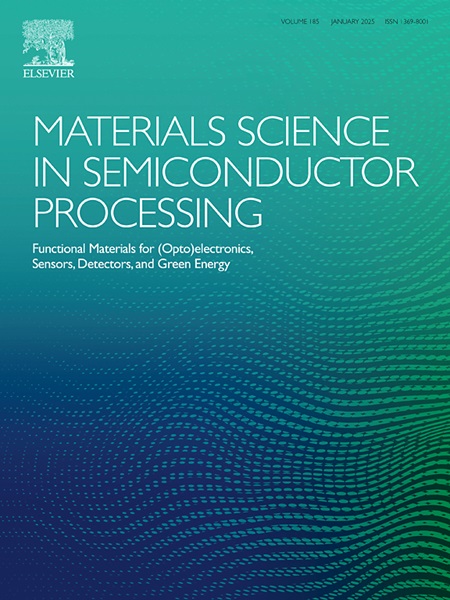In-situ hydrothermal synthesis of Bi2S3 nanoribbons to construct Bi2S3/BiVO4/TiO2 composite films with 96.1 % Cr(VI) reduction
IF 4.6
3区 工程技术
Q2 ENGINEERING, ELECTRICAL & ELECTRONIC
引用次数: 0
Abstract
With the rapid industrialization deteriorating heavy metal water pollution, photocatalytic technology has emerged as a promising solution. In this study, a novel in-situ hydrothermal technique enabled the integration of Bi2S3 nanoribbons and BiVO4 particles with TiO2 forming a stable Bi2S3/BiVO4/TiO2 composite film, and utilized sulfur (S) source concentration to regulate Bi2S3 morphology to enhance photocatalytic property of TiO2. The results show that with the introduction of S source, the morphology of Bi2S3 showed obvious evolution law. Under the low concentration of S source (1 mmol), Bi2S3 formed nanospines, evolving into nanoribbons (3,5 mmol) and nanosheets (7 mmol), with agglomeration observed at 10 mmol. When the amount of S source was 5 mmol (SVT-5), Bi2S3 nanoribbons was the most suitable morphology, and exhibited enhanced visible-light absorption and the narrowest bandgap (2.76 eV). SVT-5 demonstrated superior photoelectrochemical property: highest photocurrent density, lowest impedance, maximum carrier concentration, and prolonged carrier lifetime (15.2 ms). Under simulated solar light, SVT-5 achieved a reduction efficiency of 96.1 % and a reduction rate of 0.0336 min−1 for 5 mg/L Cr(VI) after 100 min, outperforming TiO2 and BiVO4/TiO2. Additionally, SVT-5 maintained 90 % efficiency after four cycles, highlighting its stability. This work provides a morphology-regulation strategy to enhance TiO2-based photocatalysts, offering a viable approach for heavy metal wastewater treatment and advancing applications in optoelectronics and environmental remediation.

原位水热合成Bi2S3纳米带构建Bi2S3/BiVO4/TiO2复合膜,Cr(VI)还原率为96.1%
随着工业化进程的加快,重金属水污染的恶化,光催化技术已成为一种很有前景的解决方案。本研究采用原位水热技术将Bi2S3纳米带和BiVO4颗粒与TiO2结合,形成稳定的Bi2S3/BiVO4/TiO2复合膜,并利用硫源浓度调节Bi2S3的形态,增强TiO2的光催化性能。结果表明,随着S源的引入,Bi2S3的形貌呈现出明显的演化规律。在低浓度S源(1 mmol)下,Bi2S3形成纳米棘,依次演化为纳米带(3、5 mmol)和纳米片(7 mmol),在10 mmol时出现团聚现象。当S源的添加量为5 mmol (SVT-5)时,Bi2S3纳米带的形貌最合适,具有增强的可见光吸收和最窄的带隙(2.76 eV)。SVT-5表现出优异的光电化学性能:最高的光电流密度,最低的阻抗,最大的载流子浓度,延长的载流子寿命(15.2 ms)。在模拟太阳光照下,SVT-5对5 mg/L Cr(VI)的还原效率为96.1%,还原速率为0.0336 min−1,优于TiO2和BiVO4/TiO2。此外,SVT-5在4次循环后仍保持90%的效率,突出了其稳定性。这项工作提供了一种形态调控策略来增强tio2基光催化剂,为重金属废水处理提供了可行的方法,并推进了在光电子和环境修复中的应用。
本文章由计算机程序翻译,如有差异,请以英文原文为准。
求助全文
约1分钟内获得全文
求助全文
来源期刊

Materials Science in Semiconductor Processing
工程技术-材料科学:综合
CiteScore
8.00
自引率
4.90%
发文量
780
审稿时长
42 days
期刊介绍:
Materials Science in Semiconductor Processing provides a unique forum for the discussion of novel processing, applications and theoretical studies of functional materials and devices for (opto)electronics, sensors, detectors, biotechnology and green energy.
Each issue will aim to provide a snapshot of current insights, new achievements, breakthroughs and future trends in such diverse fields as microelectronics, energy conversion and storage, communications, biotechnology, (photo)catalysis, nano- and thin-film technology, hybrid and composite materials, chemical processing, vapor-phase deposition, device fabrication, and modelling, which are the backbone of advanced semiconductor processing and applications.
Coverage will include: advanced lithography for submicron devices; etching and related topics; ion implantation; damage evolution and related issues; plasma and thermal CVD; rapid thermal processing; advanced metallization and interconnect schemes; thin dielectric layers, oxidation; sol-gel processing; chemical bath and (electro)chemical deposition; compound semiconductor processing; new non-oxide materials and their applications; (macro)molecular and hybrid materials; molecular dynamics, ab-initio methods, Monte Carlo, etc.; new materials and processes for discrete and integrated circuits; magnetic materials and spintronics; heterostructures and quantum devices; engineering of the electrical and optical properties of semiconductors; crystal growth mechanisms; reliability, defect density, intrinsic impurities and defects.
 求助内容:
求助内容: 应助结果提醒方式:
应助结果提醒方式:


